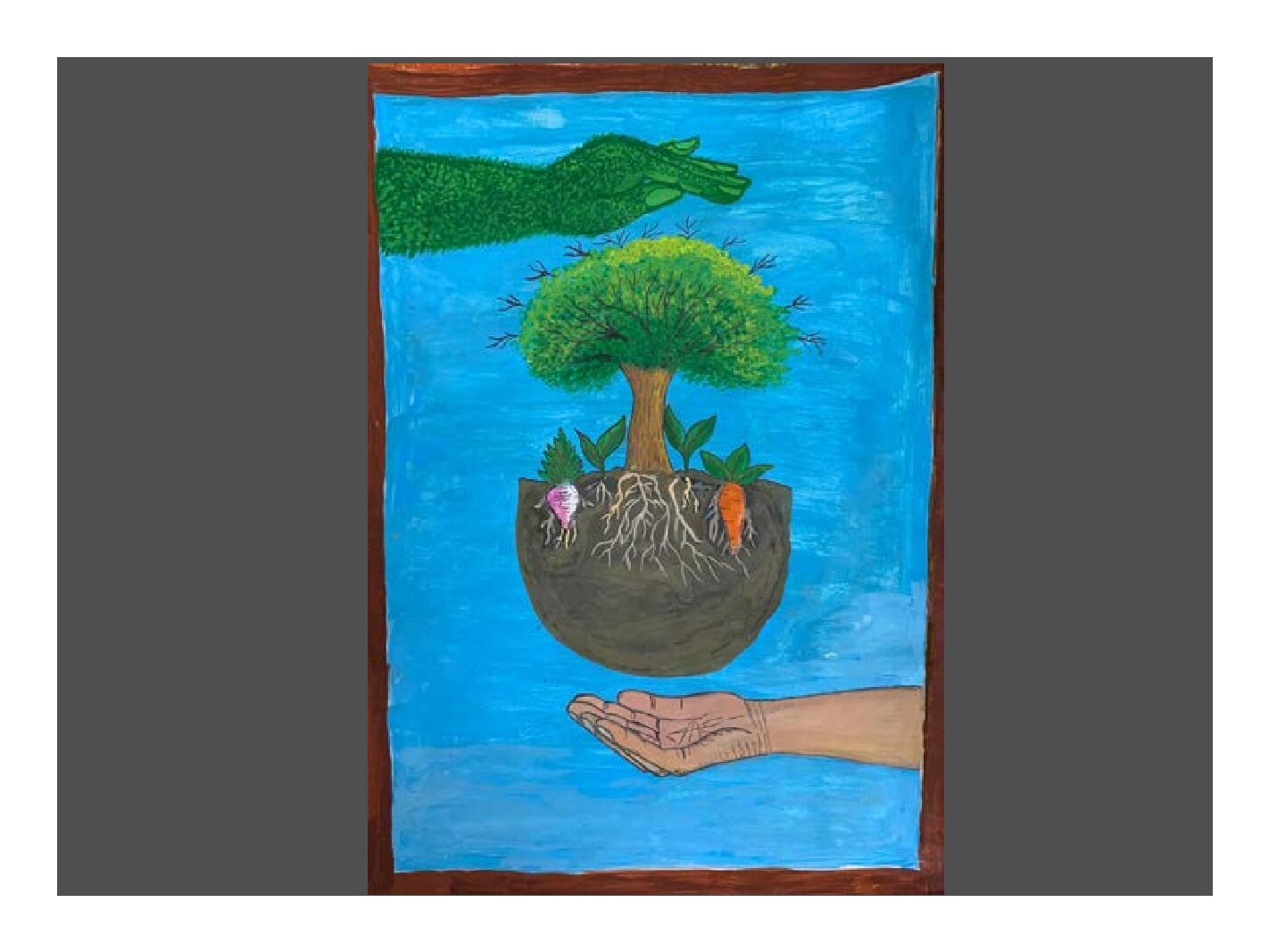Oxygenating Our One Earth: The circular economy model

Rajdeep Pathak
I was glued to an old documentary on Sundarlal Bahuguna (January 9, 1927 – 21 May, 2021) — a well-known environmentalist and leader of Chipko Movement, a person who fought for the preservation of the forests of the Himalayas in the 70s and later spearheaded the anti-Tehri Dam movement from the 1980s to early 2004 — when my daughter’s painting on preservation and protection of Mother Earth caught my attention.
She was still busy giving her work the finishing touches. What I saw was that she drew two types of hands — one brown and one green. While the brown represented us (humans) attempting to protect the soil, the green symbolised Nature nurturing our efforts by spreading her abundance around. This she said is a school project as part of the World Environment Day (June 5).
Her creative idea of protecting the planet Earth with two hands seemed perfect as far as her imagination took flight, but it is undeniable that we adults are to be blamed for the present condition of environmental degradation.
As I am writing this article sitting in my room, the outside temperature in the Capital City of Delhi is 48-degree Celsius.
I was equally reminded of a promotional video where children and adults are invited by teachers in separate sessions to draw their thoughts on environment. While parents drew plants and lush green trees and blue sky and rainbows, when the papers given to the children were placed on the table before their parents, they were startled to see what their children painted. It was dark, black and grey with no rain and rainbows.
This clearly stated how and in what condition they are living in or are bound to live for the next few decades because of what we adults have done to this planet, which we neither inherited nor owned. An honest confession, I couldn’t locate the video on YouTube.
However, another 3.27-minute hard hitting short documentary on ‘Pollution in India’ depicting how humans will live in 2030 with O2 kit for their survival is enough to open our eyes to the grave threat that is looming large upon us.
What have we done to our environment?
Led by the United Nations Environment Programme (UNEP) and held annually on June 5 since 1973, World Environment Day is the largest global platform for environmental public outreach and is celebrated by millions of people across the world.
This year it is hosted by Sweden. #OnlyOneEarth is the campaign for World Environment Day 2022. It calls for collective, transformative action on a global scale to celebrate, protect and restore our planet.
The United Nations has declared a not to be forgotten threat with a triple planetary emergency that the Earth faces:
- The climate is heating up too quickly for people and nature to adapt;
- Habitat loss and other pressures mean an estimated 1 million species are threatened with extinction;
- Pollution continues to poison our air, land and water.
It further highlights that ‘Time’ is running out, and nature is in emergency mode.
There is a need for urgent action to address these pressing issues, making “Only One Earth” and its focus on living sustainably in harmony with nature, as pertinent as ever.
While it is nothing new that our production and consumption lead to large quantities of waste, an important element in work on eco-cycles is, therefore, sustainable waste management.
We are in an era when we are driven by rapid urbanization, economic development and changing consumption and production patterns.
To protect the environment, we need to properly manage waste. It is necessary to collect the garbage dump and recycle it into reusable waste, such as water bottles, etc. Emphasis should also be given on making manure from leaves, and so on.
Another challenge before us is that of e-waste and its proper management has become very essential.
The aim as far as possible is to make use of the resources contained in waste. At the same time, it is important to reduce adverse effects in the form of emissions of methane gas from landfills and carbon dioxide from combustion.
The way forward
Governments, businesses, academia and civil society increasingly recognize that a switch towards a circular economy approach to plastic waste and waste in general is necessary to tackle many challenges faced by environment.
The goal of circular economy is:
(1) to increase the life cycle of different types of materials and waste and
(2) to facilitate their reuse by treating them as manageable resources.
Circular economy is not limited to waste management only, but starts with development and production of the product, its consumption or its use as a secondary material.
While there is no universally agreed definition of a circular economy, the 2019 United Nations Environment Assembly, the UN’s flagship environment conference, described it as a model in which the value of products and materials is maintained for as long as possible and waste and resource use are minimized. It underlines the general principle of an economy that decouples economic activities from finite primary resource consumption.
The circular economy concept entails two sets of activities: first, waste elimination through biodegradable waste composting and reusing, remanufacturing, and recycling of transformed and non-biodegradable waste, and second, switching to renewable energy instead of chemical substances.
For the circular economic model to work, there is a ned to find ways to minimize our overall material consumption. We must look at our current waste patterns and find ways to fill the gaps. And, rather than relying on raw materials, we have to find ways to use recycled resources in our manufacturing processes and to handle our waste more responsibly.
Not only this, research suggests that there is strong case for the development of innovative technologies that overcome identified challenges and support continued growth. A circular economy is not only beneficial for the environment, but it has proven economic benefits as well. In fact, research suggests that moving to a circular economy could offer $4.5 trillion in economic opportunity.
The Indian perspective
By embarking on a circular economy transformation, India could create direct economic benefits for businesses and citizens while reducing negative externalities. With its young population and emerging manufacturing sector, the country can make systemic choices that would put it on a trajectory towards positive, regenerative, and value creating development.
Reports suggests that the Indian economy has shown strong signs of being resilient during the pandemic. Efforts to make a circular transition can be seen across sectors. A lot of work in the different Ministries and Departments has been happening for quite some time.
NITI Aayog developed the Resource Efficiency Strategy in 2017 and Sectoral Strategies in 2019. NITI Aayog is giving high importance to mainstreaming the ‘2030 Agenda for Sustainable Development and achieving Sustainable Developments Goals (SDGs). One of the elements in achieving the SDGs is the transition towards a greater circular economy and resource efficiency.
The report “Circular Economy in India: Rethinking Growth for Long-Term Prosperity” by Ellen Macarthur Foundation, presents seven key insights that make the case for the application of circular economy principles in India:
A circular economy development path in India could create annual value of ₹14 lakh crore (US$ 218 billion) in 2030 and ₹40 lakh crore (US$ 624 billion) in 2050 compared with the current development scenario.
By adopting circular economy approaches, businesses could achieve material cost savings and increase their profits. The key drivers of value creation include better product design, innovative business models, and reverse logistics.
A circular economy development path could significantly mitigate negative environmental externalities. For example, greenhouse gas (GHG) emissions could be 23% lower in 2030 and 44% lower in 2050 compared with the current development scenario, helping India deliver on its targets promised in the recently ratified Paris agreement.
A circular economy could deliver benefits for the Indian population, such as cheaper products and services and reduced congestion and pollution. In all three focus areas studied, the analysis showed that the cost of providing the expected services for each citizen would be considerably lower on the circular development path than on the current path.
Leveraging digital technology to enable the circular economy could reinforce India’s position as a hub for technology and innovation. The interplay between circular economy and digital technology creates fertile ground for value creation and given its renowned IT sector, India is particularly well positioned to leverage these opportunities.
By actively leveraging and reinforcing circular economy opportunities now, India could move directly to a more effective system and avoid getting locked into linear models and infrastructure. As the systems that provide housing, food, and mobility require development in a growing economy like India’s, the country could realise significant value by developing them in a circular, rather than a linear, way.
High-growth markets like India can achieve competitive advantage over mature economies by moving to a circular economy.
While we all have been pragmatic about development and living a non-hazardous lifestyle, we must realise that we are actually dealing with an enormously growing waste problem. It is the participation of the citizenry and a conscious movement/development towards Plastic Waste Management Rules, e-Waste Management Rules, Construction and Demolition Waste Management Rules, Metals Recycling Policy, and so on that will ultimately result in turning the tables around.
(The author is programme executive at Gandhi Smriti & Darshan Samiti)




